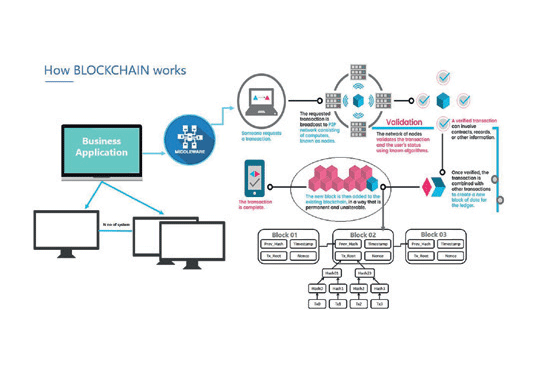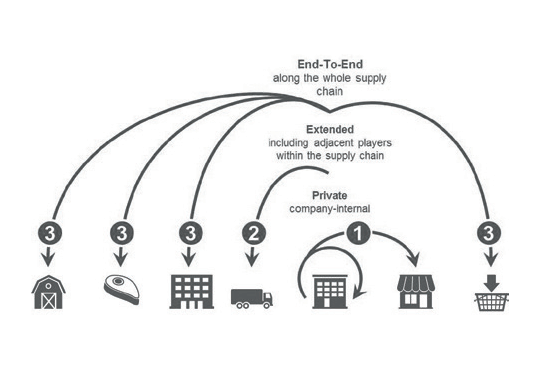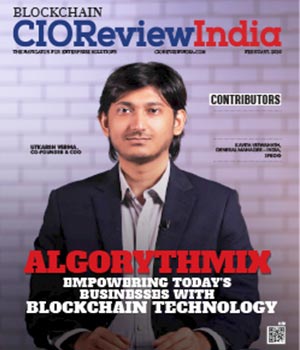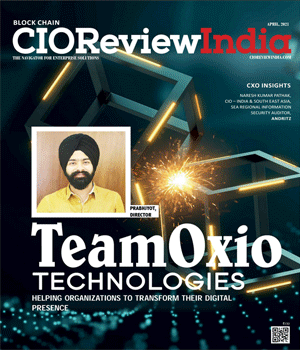
BlockChain in Supply Chain
Sugata Roy, MD & CEO, arodek Technology Consulting Pvt. Ltd.
 Supply chain has become complicated. Some would say cumber some. It takes days to make a payment between a manufacturer and a supplier, or a customer and a vendor. Contracts must be handled by lawyers and bankers, which means extra cost and delay. Products and parts are often hard to trace back to suppliers, making defects difficult to eliminate. Whether for industrial equipment, consumer goods, food products, or digital offerings, supply chains have headaches a-plenty. The wide variety and massive number of entities that participate in this two-way flow of materials, information and money is noteworthy. Be it producers, distributors, retailers or customers, a sound supply chain management has the ability to positively impact your business but a defective supply chain is equally powerful to negate the smooth flow of operations.
Supply chain has become complicated. Some would say cumber some. It takes days to make a payment between a manufacturer and a supplier, or a customer and a vendor. Contracts must be handled by lawyers and bankers, which means extra cost and delay. Products and parts are often hard to trace back to suppliers, making defects difficult to eliminate. Whether for industrial equipment, consumer goods, food products, or digital offerings, supply chains have headaches a-plenty. The wide variety and massive number of entities that participate in this two-way flow of materials, information and money is noteworthy. Be it producers, distributors, retailers or customers, a sound supply chain management has the ability to positively impact your business but a defective supply chain is equally powerful to negate the smooth flow of operations.

Over the years, transparency within the chain has been the primary, if not the sole, issue within a supply network. Organizations still struggle to figure out the true value of products and services they purchase, as they are not guaranteed that the product expenses are an accurate reflection of true costs of production. This can be addressed by the distributed nature of blockchain technology which allows authenticated data communication between each supply chain player without the intervention of third parties. It is primarily a digital ledger spread across all the supply chain units that gives a clear timeline of who did what and when (purchase/sell/authenticate etc.) – a valuable requisite in the otherwise vulnerable procedures of a supply chain involving multiple entities with multiple roles and authorities.
A Blockchain Primer for Supply Chain
What is blockchain? Here’s a simple explanation. A blockchain is a distributed, digital ledger. The ledger records transactions in a series of blocks. It exists in multiple copies spread over multiple computers, which are also called nodes. The ledger is secure because each new block of transactions is linked back to previous blocks in a way that makes tampering practically impossible. As it is decentralised, it does not depend on any single entity (like a bank) for safekeeping. The nodes connected to the blockchain network get updated versions of the ledger as new transactions are made. The multiple copies of the ledger are the “truth” about every transaction made so far in the blockchain. Trying to falsify the ledger would mean having to falsify the copies at precisely the same moment. The chances of being able to do this in blockchain networks of any useful size are negligible.
Key blockchain features map into the basic needs for reliability and integrity for a supply chain, shown below:
• Consensus: All the entities in the chain agree that each transaction is valid. For supply chain, it could be payment, warehousing, transport or delivery.
• Provenance: The entities in the chain know where each asset came from. They also know who owned it before and at what time. For supply chain, assets can be anything from iron ore and wheat to money, machines and copyrights.
• Immutability: No entity can tamper with an entry in the distributed ledger. Supply chain payments cannot be falsified. Neither can records of inventory, warehousing conditions, delivery times and dates, and so on.
• Finality: The copies of the shared ledger all hold the same version of the truth.
Applications of Blockchain in Supply Chain
The following examples are now in use or can be implemented today using existing technology.
• Automotive supplier payments
Blockchain allows the transfer of funds anywhere in the world. Traditional banking methods are not needed. Transfer is direct between payer and payee. It is also secure and rapid – in minutes, compared to days for automated clearing house payments, for example. The advantage is in the cost savings.
• Product traceability
Product status at each stage of production can be recorded using blockchain. The records are permanent and inalterable. They also allow the tracing of each product to its source. Global retailer Walmart uses blockchain to track sales of pork meat in China. Its system lets the company see where each piece of meat comes from, its processing and storage, and sell-by date.
• Electric power micro grids
Smart contracts are being used for redistributing excess power from solar panels. The Trans active Grid is an application running on blockchain to monitor and redistribute energy in a neighborhood micro grid. The program automates the buying and selling of green energy to save costs and pollution.
• RFID-driven contract bids and execution
RFID tags for cartons or pallets store information on delivery location and date. Logistics partners run applications to look for these tags and bid for delivery contract.
The partner offering optimal price and service gets the business. A smart contract then tracks status and final delivery performance.
• Cold chain monitoring
Food and pharmaceutical products often need special storage. Also, enterprises see the value in sharing warehouses and distribution centres, instead of each one paying for its own. Sensors on sensitive products can record temperature, humidity, vibration, and other items of interest. These readings can then be stored on blockchain. They are permanent and tamper proof. If a storage condition deviates from what has been agreed, each member of the blockchain will see it. A smart contract can trigger an action to correct the situation. Depending on the size of the deviation, this action may be to simply adjust the storage. However, it could also extend to changing “use-by” dates, declaring products unfit, or applying penalties.
• Blockchain and Internet of Things (IoT):
Other ambitious ideas come from using blockchain and IoT. One suggestion is for smart contracts to manage rentals of driverless cars. A smart contract could check for rental payments. If payment has not been made or simply at the end of the rental contract, the smart contract could lock the car and tell it to drive itself back to the renter.
Challenges to Be Met
Blockchain has its challenges too. Enterprises that want to harness blockchain power for their supply chain will need to watch out for the following.
• Ecosystem still in progress
The first telephone was useless until the second one arrived. In time the phone spread all over the world and now we can’t do without it. The situation is similar for blockchain and companies that want to do business with specific partners. Those partners will need to buy into blockchain as well. It may be just a matter of time until businesses “join the dots” for widespread acceptance.
• Technology and knowhow
Blockchain programming takes a mix of software skills. It also helps to understand economies and businesses, especially your business. You may have to train staff or hire new people with these skills. You could also outsource your blockchain development to a third party. The best choice for you will depend on your current situation and future aspirations.
• Mindset
Blockchain was started by people who wanted to decentralise applications and operations. They wanted to make dependency on centralised entities like banks optional instead of obligatory. This is a new way of thinking. Don’t be surprised if it takes you or your colleagues a little time to shed your mental shackles and get into the swing of the blockchain movement.

Keys to Successful Integration
In arodek experience, a 3-STEP approach to gradually integrate blockchain into supply chains is most advantageous model. To start, a company-internal blockchain should be set up, giving the organization time to get accustomed to the technology, while ensuring data availability and consistency. Next, extend the blockchain to adjacent players, such as third-party logistics and direct suppliers, fostering data exchange. Finally, integrate all players along the supply chain, including the end customers, to the blockchain.
At its full potential, blockchain improves the customer experience, drives value end-to-end, and roots out inefficiencies, thereby lowering costs.
Conclusion
Blockchain can transform supply chains, industries and ecosystems. With the adoption of blockchain, all your supply chain processes can be transparent to you and your stakeholders, yet be secure at the same time; a contradicting combination offered cohesively. From raw materials to finished products, replenishment of inventory to sales invoices, you are in control of each element of your demand-supply cycle. Smart contracts can help eliminate costly delays and waste currently due to manual handling of paperwork. From there, the door is then open to smarter, faster, more secure supply chain from one end to the other. We, at arodek, firmly believe in the power of blockchain and its potential to deliver substantial business value to every enterprise by increasing transparency, reducing risks and improving efficiency of the overall supply chain management.
CIO Viewpoint
Why Foolproof Facial Recognition Is Key Against...
By Joseph Sudheer Thumma, Global CEO & MD, Magellanic Cloud
National Technology Day 2025: Powering Progress...
By CIOTech Outlook Team
Aligning IT Roadmap with Business Objectives: A...
By Subhash singh Punjabi, CISO & Head Enterprise Architecture, Deepak Fertilisers & Petrochemicals Corporation Ltd
CXO Insights
Blockchain: Revolutionizing Industries, One...
By Dr. Arvind Deendayalan, Global Practice Head - Blockchain, Infovision
Dissecting The Role Of DevOps In Contemporary ERA
By Kavita Viswanath, General Manager - India, JFrog
Advisory FOR CXOs At A Crossroads To Modernize...


.jpg)
.jpg)






